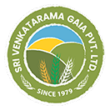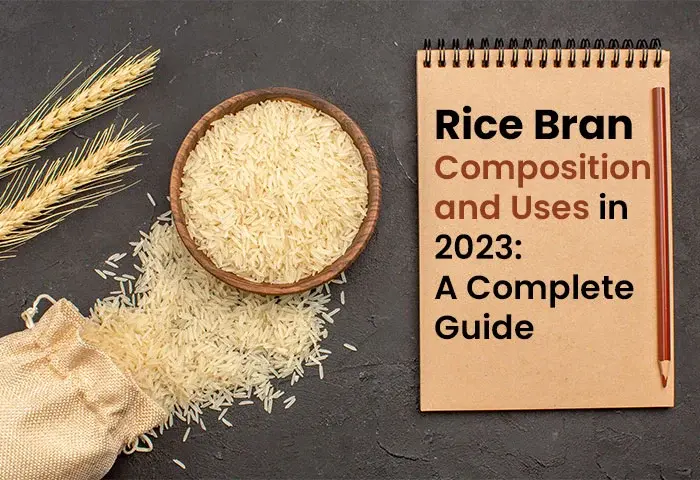Rice, the staple food for more than half of the world’s population, has been an integral part of our diets for centuries. But there’s more to rice than just its grains. Hidden within its protective layers lies a treasure trove of nutrition and versatility – rice bran. Often overlooked and discarded, rice bran is a powerhouse of nutrients and has many applications beyond the plate.
In this blog we will explain rice bran, exploring its composition, health benefits, and diverse uses beyond being a dietary staple. Whether you’re a nutrition enthusiast, a health-conscious individual, or simply curious about the potential of this humble byproduct, join us on a journey to uncover the numerous facets of rice bran. From its role in promoting well-being to its applications in various industries, rice bran is a natural resource that deserves our attention.
Rice Bran Composition
Rice bran is made up of 50% carbohydrates (mostly starch), 20% fat, 15% protein, and 15% dietary fiber (primarily insoluble fiber). The exact nutritional content can vary depending on the type of rice and the milling process. Due to these nutrients and bioactive compounds, rice bran has been studied for its potential health benefits.
| Nutrient | Amount |
| Energy (kcal) | 316 |
| Protein (g) | 13.35 |
| Total fat (g) | 20.85 |
| Saturated fatty acids (g) | 4.17 |
| Monounsaturated fatty acids (g) | 7.55 |
| Polyunsaturated fatty acids (g) | 7.46 |
| Carbohydrate (g) | 49.69 |
| Fiber, total dietary (g) | 21.00 |
| Minerals | |
| Calcium (mg) | 57.00 |
| Iron (mg) | 18.54 |
| Magnesium (mg) | 781.00 |
| Phosphorus (mg) | 1677.00 |
| Potassium (mg) | 1485.00 |
| Zinc (mg) | 6.04 |
| Manganese (mg) | 14.21 |
| Selenium (µg) | 15.60 |
| Vitamins | |
| Thiamine (mg) | 2.75 |
| Riboflavin (mg) | 0.28 |
| Niacin (mg) | 34.00 |
| Pantothenic acid (mg) | 7.39 |
| Vitamin B6 (mg) | 4.07 |
| Folate (µg) | 63.00 |
| Choline (mg) | 32.20 |
| Vitamin E (alpha-tocopherol) (mg) | 4.92 |
| Vitamin K (phylloquinone) (µg) | 1.90 |
Nutrient Profile
- Fiber: Rice bran is rich in dietary fiber, with soluble and insoluble fractions. This fiber aids digestion, regulates blood sugar levels, and supports heart health.
- Lipids: Rice bran oil, derived from rice bran, is well-known for its high levels of unsaturated fatty acids, including oleic and linoleic acids. These fats are considered heart-healthy and can help reduce LDL cholesterol levels.
- Vitamins: Rice bran is a good source of various vitamins, such as B vitamins (thiamine, niacin, riboflavin, etc.), which are crucial for energy metabolism and overall health.
- Minerals: It contains essential minerals like potassium, magnesium, and phosphorus, which play pivotal roles in maintaining bodily functions, including bone health and muscle contraction.
Protein Content
Rice bran protein boasts a substantial protein content, complete with essential amino acids, making it a valuable addition to plant-based diets and a source of muscle-building nutrients. Comprising approximately 10–15% of their composition, these proteins can be further classified into distinct solubility fractions: 37% are water-soluble, 31% are salt-soluble, 2% are alcohol-soluble, and 27% are alkali-soluble storage proteins. What distinguishes rice bran protein are its unique attributes, including hypoallergenic properties and the presence of anti-cancer characteristics, positioning it as an exceptional cereal protein with the potential for a wide range of applications.
Phytochemicals and Antioxidants
Rice bran is rich in phytochemicals, including:
- Tocopherols and Tocotrienols: These forms of vitamin E possess potent antioxidant properties, protecting cells from oxidative damage.
- Phytosterols: These compounds have cholesterol-lowering effects and are beneficial for heart health.
- Polyphenols: Rice bran contains various polyphenolic compounds that exhibit antioxidant and anti-inflammatory activities.
Rice bran Applications
- Nutritional Supplements: Rice bran is increasingly used as a key ingredient in dietary supplements due to its rich nutrient profile and potential health benefits.
- Functional Foods: The incorporation of rice bran into food products like cereals, bread, and snacks can enhance their nutritional value.
- Cosmetics: Extracts from rice bran are used in skincare products for their antioxidant and anti-aging properties.
- Animal Feed: Traditionally, rice bran remains an essential component of animal feed, providing necessary nutrients for livestock.
Here are Some Rice Bran Uses of :
- Cooking Oil: Rice bran oil is known for its high smoke point and neutral flavour, making it an excellent choice for frying, sautéing, and deep-frying. It is a healthier alternative to many other cooking oils due to its low saturated fat content and high levels of heart-healthy unsaturated fats.
- Baking: Rice bran can be added to baked goods like muffins, bread, and cookies to increase their fiber content and improve texture. It can replace some of the flour in recipes to boost nutrition.
- Animal Feed: Rice bran is valuable in animal feed formulations, especially for poultry and swine. It provides essential nutrients and energy, helping to improve animal growth and production.
- Skin Care Products: Rice bran oil and extracts are used in cosmetics and skin care products due to their moisturizing and antioxidant properties. They can be found in creams, lotions, soaps, and hair care products, helping to promote healthy skin and hair.
- Biodegradable Packaging: Rice bran can be used as a raw material for producing biodegradable packaging materials, reducing the environmental impact of plastic packaging.
- Soil Conditioner: Rice bran can improve soil quality as an organic soil conditioner. It adds organic matter, improves soil structure, and enhances nutrient retention, making it beneficial for agriculture.
- Health Supplements: Rice bran supplements are available in capsules or powders to promote heart health, manage cholesterol levels, and support weight loss.
- Rice Bran Wax: Rice bran wax is extracted from rice bran oil and is used in various industries, including cosmetics, candles, and polishes.
Rice Bran Benefits
- Weight Management: Including rice bran can support weight management efforts. The fibre content promotes satiety, helping to curb overeating, and the balanced nutrient profile ensures you get essential vitamins and minerals without excessive calories.
- Gluten-Free Option: Rice bran is naturally gluten-free, making it an excellent choice for individuals with gluten sensitivities or celiac disease.
- Digestive Health: The insoluble fiber in rice bran supports a healthy digestive system by adding bulk to stool, preventing constipation, and promoting regularity.
- Versatile Culinary Ingredient: Rice bran can be easily incorporated into your diet. You can use it as a topping for yogurt or cereal, mix it into smoothies, or incorporate it into baked goods like muffins and pancakes for an added nutritional boost.
Key Rice Bran Byproducts
- Rice Bran Oil:
-
-
- Rice bran oil is one of the most well-known byproducts of rice bran. It is renowned for its health benefits and versatility in cooking.
- This heart-healthy oil is rich in antioxidants and is a source of gamma oryzanol, which can help lower cholesterol levels.
- Rice bran oil also has a high smoke point, making it suitable for frying and high-heat cooking.
-
- Animal Feed:
-
-
- Rice bran is an excellent source of nutrition for livestock and poultry.
- It provides essential nutrients like protein, fiber, and energy for animal growth and health.
- Its high-fat content makes it a valuable addition to animal feed formulations.
-
- Cosmetics and Personal Care:
-
-
- Rice bran extract and oil are popular ingredients in cosmetics and skincare products.
- These byproducts are rich in antioxidants and can nourish the skin, promote cell regeneration, and reduce the signs of aging.
- Rice bran’s gentle exfoliating properties make it suitable for scrubs and masks.
-
- Brewing and Distillation:
-
-
- In the brewing industry, rice bran can produce sake and other alcoholic beverages.
- Its enzymes help break down starches into sugars during fermentation.
- In distillation, it can be used to produce spirits like rice-based whiskey.
-
- Biodegradable Packaging Material:
-
- Rice bran-based biodegradable packaging is an eco-friendly alternative to traditional plastic packaging.
- It is sustainable, renewable, and compostable, reducing the environmental impact of packaging waste.
To Sum it Up
This comprehensive guide has shed light on rice bran’s incredible versatility and significance and various byproducts. From the kitchen to the farm and even into the world of cosmetics and packaging, rice bran has proven to be a valuable and multi-faceted resource.
Get in touch with SVR Oil now and discover the excellence of rice bran and its uses.

